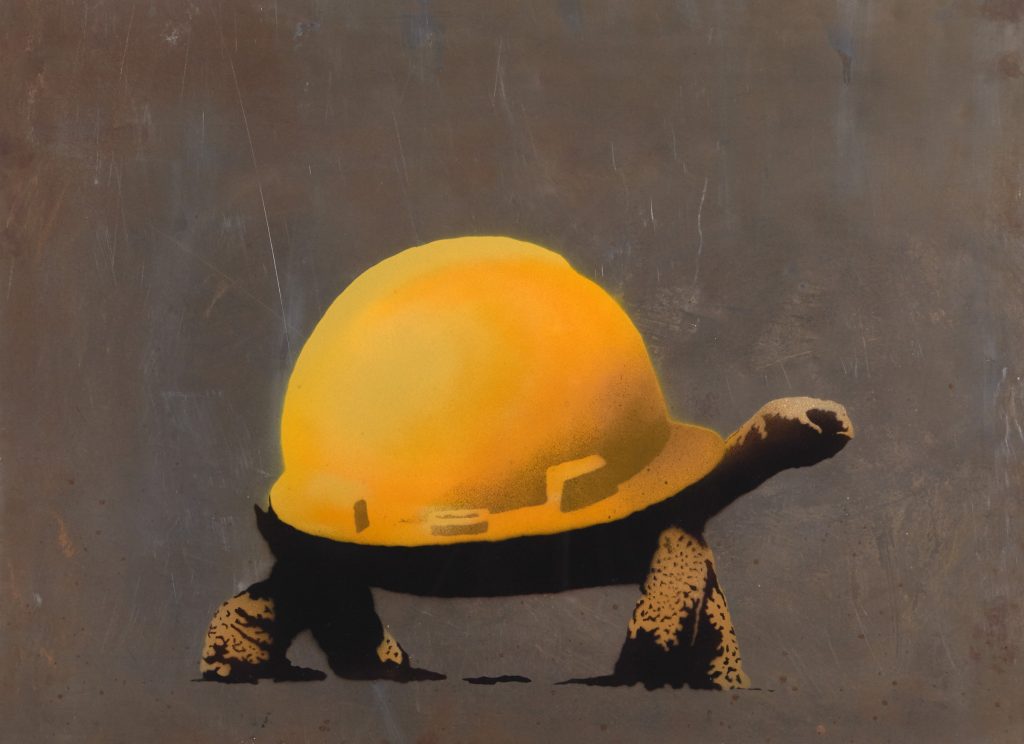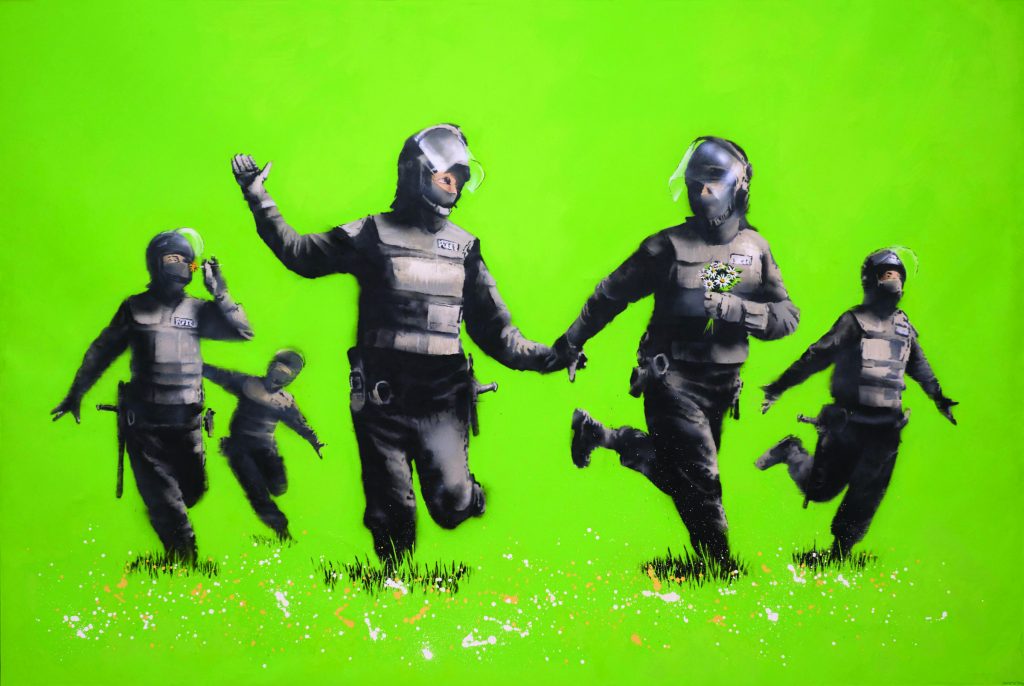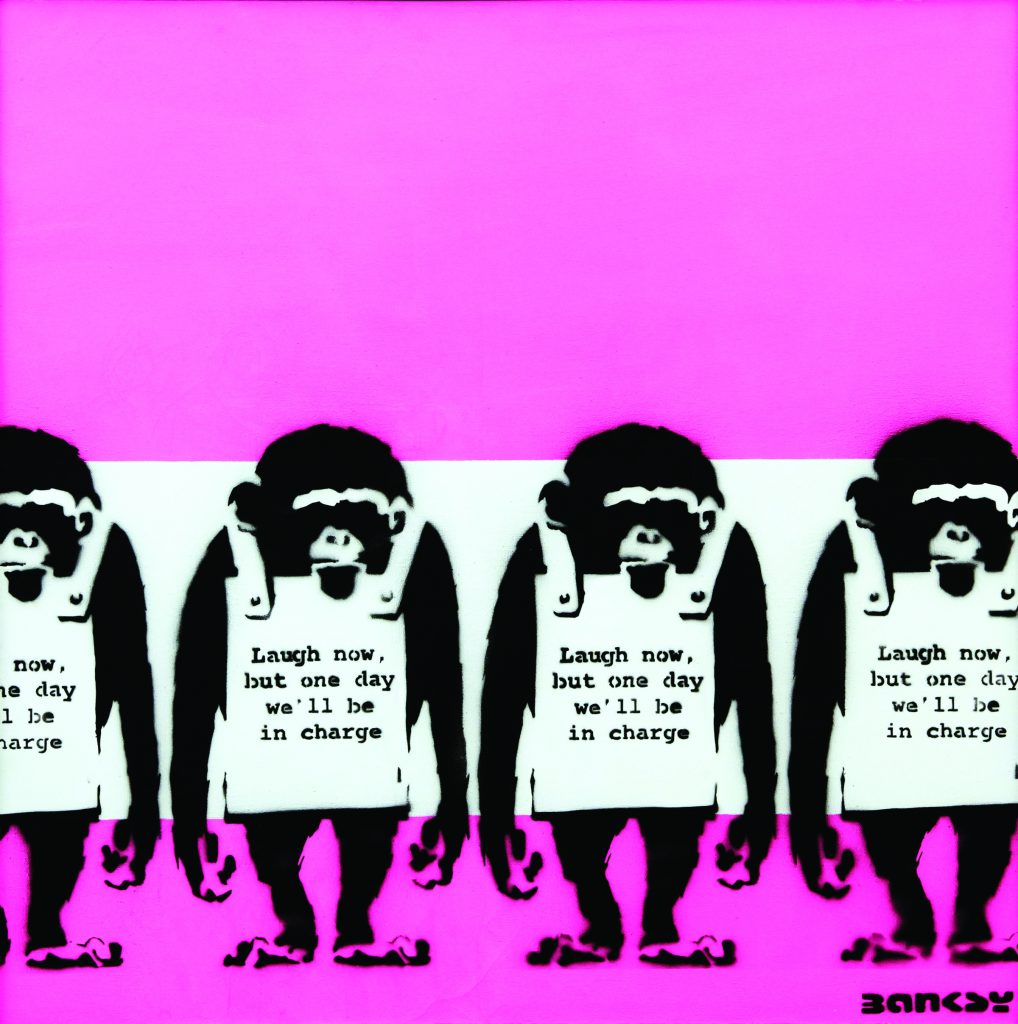There is only one Banksy
Bristol-born Banksy started spray painting freehand in the early 1990s, when he was part of a group of boys who called themselves Bristol's DryBreadZ Crew (DBZ). His personal style developed, and Banksy started predominantly using stencils – a faster and more effective method – to avoid arrest.
My plan to visit the Van Gogh Museum in Amsterdam was soon forgotten when, on arriving at Amsterdam Central Station, I noticed a poster advertising the Banksy exhibition at the MOCO. I had never seen Banksy work exhibited in a gallery! Since appreciating some of his outdoor art in situ in his early London days, I have been a fan and follower of his street art with its witty commentary on society.
From Basquiat to Banksy, street art sprang from the urge of youth for self-expression and not from the classrooms of classical art schools. However, street art is now fully recognised as an artistic form and is steadily becoming one of the most prolific art forms of the 20th century.
Bristol-born Banksy started spray painting freehand in the early 1990s, when he was part of a group of boys who called themselves Bristol’s DryBreadZ Crew (DBZ). His personal style developed, and Banksy started predominantly using stencils – a faster and more effective method – to avoid arrest. Marked by bold images with hard-hitting underlying messages and witty slogans, his art soon gained popularity.

By 1999, he was heading for London and it was around this time that he began retreating into anonymity. The reason for Banksy’s secretive is often related to the fact that graffiti was and still is deemed illegal. Evading the authorities is certainly one explanation. On the flipside, Banksy also discovered that anonymity created its own invaluable buzz. As his street art appeared in cities across Britain, comparisons to Jean-Michel Basquiat and Keith Haring began circulating. A couple of decades later and Banksy is one of the most influential artists of our time.
The MOCO is the most recent addition to Amsterdam’s Museumplein. It is located in Villa Alsberg, a grand townhouse designed in 1904 by Eduard Cuypers. The owners, Lionel and Kim Logchies, commissioned Studio Piet Boon, who updated the interior to contrast with the historic façade. Initially, it appears an unusual space in which to find an art gallery, but the Villa acts as a perfect counterpart to the contemporary art paintings and objects which are showcased inside. The building’s interiors are both preserved and adapted superbly into a functioning museum.
MOCO’s remit is to reach out to an international young audience, and currently the museum is running a dual exhibition alongside the Banksy ‘Laugh Now’ exhibition – the Roy Lichtenstein ‘Lasting Influence’. This dual exhibition showcases more than 50 works of art from both artists.
The Banksy exhibition is displayed in the rooms and corridors of the first two levels of the art gallery. The work is a mixture of sculptures and indoor and outdoor art. Well known for his outdoor street art which can be found in various parts of the world, not many people know that Banksy also does indoor art and I had never seen any before. The mixed media pieces displayed at the MOCO are owned by collectors who had bought them at previous Banksy exhibitions.
Witnessing so much of his art in one space is a journey through some pivotal political moments in our recent history. The pieces included are some of his most famous works such as Laugh Now, Barcode, Girl with Balloon, Jerry Crude Oil; Kids on Guns, Pulp Fiction, Flower Thrower, Monkey Queen, Kate Moss, Bomb Hugger, Soup Can and Beanfield.
Beanfield is one of Banksy’s legendary and most striking pieces. Measuring an impressive 2.5 x 3.5 metres, is has not been on display since 2009. It shows a group of five riot police running through a green field, smelling the flowers and holding hands. The huge canvas, located among wooden panels and soft grey walls, shows a humorous nudge towards the police brutality at the Battle of Beanfield in 1985, which was an attack on a convoy of travellers heading for Stonehenge to set up a free festival. This is a very important canvas that characterises Banksy as an activist artist.

There is a highlight at the top of the staircase that took my breath away with its stark innocence and vibrant colour. ‘Forgive us for Trespassing’ hangs between the light of two stained glass windows in a classical setting and is the first art work the visitors see as they walk through the entrance. Here Banksy plays on Christianity’s The Lord’s Prayer, relating it to the illegality of graffiti art. This is addressed by the very literal image of a boy praying for forgiveness in front of graffiti on a church window.
On the same theme, a statement sculpture in the exhibition is “Cardinal Sin”, a bust with its face sawn off and replaced by blank tiles, designed as a response to the child abuse scandal in the Catholic Church. In a statement, Banksy said: “I’m never sure who deserves to be put on a pedestal or crushed under one.”
Also framed on a wall is his infamous ‘Banksy of England’ note. He gained a lot of exposure with this in 2004, when he produced a quantity of spoof British £10 notes substituting the Queen’s head with the head of Diana, Princess of Wales and changing the text ‘Bank of England’ to ‘Banksy of England’. In October 2007, one of these notes was sold at Bonhams auction house in London for £24,000.
In addition to the canvases, sculptures and drawings, during the tour you can also see hilarious messages that the artist captured in some altarpieces, such as ‘I wanted wine, women and song. I got a drunk woman singing.’
Overall a comprehensive display of Banksy’s works in one art gallery, the MOCO presents the works with dignity, a superb first exhibition in an art gallery for the ‘provocateur’ artist, who, in 2010, was selected by Time magazine for inclusion in its list of the world’s 100 most influential people.
Banksy sees great potential for new contemporary artists, saying, “There’s a whole new audience out there, and it’s never been easier to sell [one’s art]. You don’t have to go to college, drag ’round a portfolio, mail off transparencies to snooty galleries or sleep with someone powerful, all you need now is a few ideas and a broadband connection. This is the first time the essentially bourgeois world of art has belonged to the people. We need to make it count.” (From an interview with Will Ellsworth-Jones for Smithsonion magazine)

And so, the diverse work continues. In March last year, Banksy opened The Walled Off Hotel in the little town of Bethlehem – a place under Israeli occupation, overlooked by a vast security wall, under the gaze of Israeli checkpoints controlling the roads in and out.
This Christmas, in a bid to bring some festive cheer to what Banksy calls “the least Christmassy place on earth”, the artist decided to stage ‘Alternativity’ in the car park of his hotel around the corner from Manger Square, in Bethlehem – believed to be the birthplace of Christ himself. But as a famously anonymous graffiti artist, who has never put on a play, he was going to need some help – so he contacted the celebrated Oscar-winning film director Danny Boyle, who decided to accept this unorthodox request from the man with no face. The event, performed by children from the neighbourhood who had never heard of Banksy before, was a great success. A documentary about the making has been produced and published on YouTube.
Banksy: Laugh Now at MOCO, Honthorststraat 20, 1071 Amsterdam, is open until 31 May.
www.mocomuseum.com








